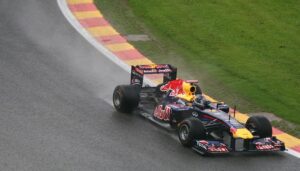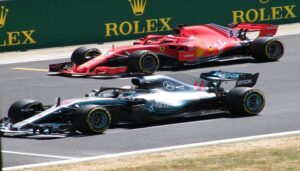There are many long-running debates that divide sports fans worldwide and can probably never be settled. Was the Hand of God a handball or not? Who is the best football coach ever? Are you Camp Messi or Camp Ronaldo? Camp Tyson or Camp Ali?
And then there are the petrol-heads: Eavesdrop on F1 fans on any race day and you’ll find them choosing hills to die on: Best driver: Hamilton or Schumacher? Best race ever: Germany 2019, Brazil 2012, Australia 1994 or Australia 1986?
And the best tracks? Ask ten F1 fans and you’re likely to get at least ten answers. Serving more than 160 destinations around the world from their Doha hub, Hamad International Airport, Qatar Airways’ crew get to go lots of places, often. They share some views about their favourite tracks, as well as crowds, atmosphere and backdrops:
- Suzuka: The scene of some of F1’s most memorable moments, the course was originally designed as a test track for Honda and features a fairly unique figure-of-eight configuration with an overpass. Michael Schumacher described his performance in the 2000 Japanese Grand Prix as “The race of my life” a few years before suffering serious head-injuries while skiing in 2003.
- Trivia: Drama? How about the much-anticipated 1989 race, where the rivalry between McLaren teammates Alain Prost and Ayrton Senna culminated in a collision ultimately led to Senna’s disqualification?

- Qatar: After not hosting the F1 race year as it prepared for the FIFA World Cup, the Gulf state’s Losail International Circuit will again reverberate with the scream of engines’ 15 000rpm. Unusually, this year’s race will run at night. Sir Lewis Hamilton will remember the 5.8km circuit fondly as it was where he won his 10th F1 race, in 2021.
- Trivia: If you’re even vaguely a sports fan, no visit to Doha is complete without a visit to the state-of-the-art seven-storey 3-2-1 Qatar Olympic and Sports Museum. Unforgettable.
- Brazil: Motor-racing in Brazil traces its roots back to 1934, with F1 races run at the renowned Autódromo José Carlos Pace intermittently for the last 50 years before moving to Sao Paulo’s Interlagos track. To say Brazil has a strong F1 fan-base is an understatement: the venue is likely to have around 170 000 spectators over the three days of F1 racing, with tickets selling out almost immediately.
- Trivia: Home-ground advantage seems to be a factor, with five Brazilian drivers having won F1 races on their own turf, or rather tar: Emerson Fittipaldi, Carlos Pace, Nelson Piquet (Father of Max Verstappen’s partner, Kelly Piquet), Ayrton Senna and Phillipa Massa.
- Silverstone: Always one of the fastest circuits, built on what was once an airfield, it’s generally regarded as a hallowed cathedral of modern motorsport. Sir Lewis Hamilton likened driving the track to flying a fighter-jet and corners like Abbey, Maggotts and Becketts challenge the sharpest drivers. The atmosphere? British sports-fans generally tend to be vocal and partisan, so expect plenty of friendly send-ups and banter.
- Trivia: The first formal race at Silverstone race in 1947 claimed the life of a hapless sheep that wandered onto the circuit.
- Hungary: The Hungaroring track was famously built in just nine months and features so many corners and so few straights that it’s been compared to a go-kart track. Apart from lots of braking and acceleration, the topography makes a track a fan favourite: Because it’s built in a bowl, you can see most of action from the stands.
- Trivia: Summer in Hungary can be very hot, but the fabulously named Mogyorodi Aquarena vizi szorakoztatopark water-park nearby offers cool succour, and the beautiful city of Budapest is just 20kms away.

- Belgium: The Spa Francorchamps course is built in the hilly Belgian Ardennes and a favourite of drivers hoping to showcase their skills. For good reason: The daunting Eau Rouge/Raidillon corner features an elevation change of 35 meters from its lowest to highest point. It also has razor-thin margins for error, even by F1 standards: 12 of the last 21 Belgian Grands Prix have been won by less than five seconds.
- Trivia: It’s been won by all-time greats of the sport: Michael Schumacher, Ayrton Senna, and Kimi Räikkönen, Lewis Hamilton and Jim Clark.
- Netherlands (27 August) Circuit Zandvoort is one of the shorter tracks on the F1 calendar and its layout means that spectators see cars screaming past more often than other races, with fast, banked turns shaped by the dunes of the nearby North Sea. The severity of the corners and the frequency with which cars spun off the track led the organisers to install a metre-wide buffer of resinised gravel to reduce risks slightly. Previous winners include Stirling Moss, Graham Hill, Jim Clark, Jackie Stewart, James Hunt and Niki Lauda.
- Trivia: Arguably the most memorable victory on the track – perhaps in F1 history – was in 1985 when Niki Lauda had to start in 10th place and worked his way up to win. He was joined on the podium by fellow icons Alain Prost and Ayrton Senna. It was Lauda’s final victory.
- Italy (3 September): While not all Italy’s Grands Prix have been run at Monza, the race is the world’s fifth oldest. Monza is in the grounds of Europe’s biggest city park and the race draws the fanatical Tifosi, most of whom are Ferrari zealots. Atmosphere? The event can accommodate 100 000 fans, many of whom regard missing 2020’s race – held behind closed doors due to Covid19 – as personal slight. Expect to hear not just the roar and scream of high-performance engines.
- Trivia: The circuit is uniquely punishing for driver and machine because of its combination of long straights and slow chicanes: Engines are on full power for 80% of each lap, while gearchanges through the chicanes take their toll on transmissions.




